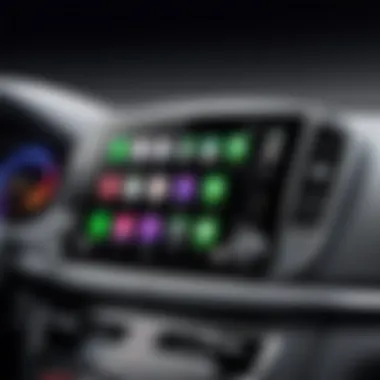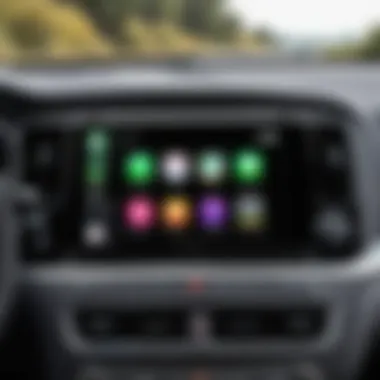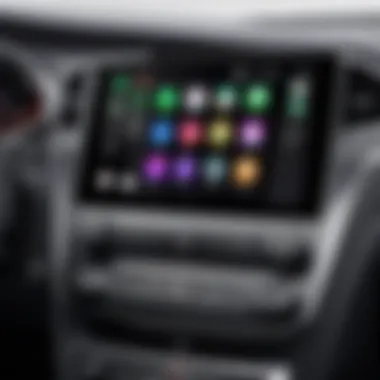Understanding Apple CarPlay and Sync 3 Integration


Intro
In today's tech-driven world, the integration of mobile devices with vehicle infotainment systems has become vital for many users. Among the options available, Apple CarPlay and Ford's Sync 3 stand out. This article delves into these technologies, discussing their functionality, compatibility, and user experiences. It aims to illuminate the various features and benefits of connecting Apple devices to vehicles equipped with Sync 3, while also comparing it to other infotainment solutions.
The relevance of this topic cannot be understated. As more drivers seek seamless connectivity on the road, understanding these systems and how to maximize their capabilities is essential. Moreover, this knowledge can empower IT professionals and technology enthusiasts to explore vehicle connectivity technologies further.
Next, we will take a closer look at the product itself.
Prelude to Apple CarPlay
In today's digital world, vehicles are no longer just tools for transportation; they have evolved into sophisticated platforms for connectivity and entertainment. This transformation is where Apple CarPlay comes into play. Understanding Apple CarPlay is essential as it bridges the gap between mobile technology and the automotive experience. It enhances user convenience by providing a seamless way to integrate iPhone functionalities with the car’s interface.
This guide will delve into the core elements of Apple CarPlay, shedding light on its impact and advantages, especially for those who prioritize connectivity while on the road. By studying this integration, we acquire insights about how it reshapes daily commutes and long journeys alike.
What is Apple CarPlay?
Apple CarPlay is a feature developed by Apple Inc. that allows users to connect their iPhones directly to their vehicle's infotainment system. Through this connection, drivers can use various applications and features of their phones in a manner that emphasizes safety and user-friendliness while driving.
After connecting an iPhone, the vehicle's display mirrors specific apps that are optimized for the driving context. This usually includes navigation apps, music streaming, and messaging applications. Moreover, voice commands via Siri offer an effective hands-free option, enabling drivers to access functions without diverting their attention from the road.
Key Features of Apple CarPlay
Apple CarPlay boasts several features designed to enhance the driving experience. Some of the primary functionalities include:
- Navigation: Built-in navigation systems, combined with apps like Apple Maps or Google Maps, assist drivers in finding directions easily and efficiently.
- Music Streaming: Users can access their favorite music through platforms like Apple Music and Spotify, making it easy to curate playlists on the go.
- Messaging: CarPlay allows drivers to send and receive messages via apps like WhatsApp or iMessage using voice commands, maintaining safe communication.
- Calls: Placing calls is straightforward, as Siri manages the process, letting you stay focused on driving.
- Third-Party App Integration: CarPlay supports variety of third-party applications, such as Waze and TED, expanding functionality beyond Apple's native offerings.
These features represent a combination of safety, convenience, and entertainment, which is essential for modern drivers.
The Evolution of CarPlay
Since its introduction in 2014, Apple CarPlay has undergone significant changes and improvements. Originally launched as a simple application mirroring platform, it has evolved into a more integrated and sophisticated system. Apple has consistently improved the interface, adding new features, expanding compatibility with devices, and enhancing usability based on user feedback.
One notable advancement is the increased functionality for Siri, allowing for more natural language processing and context recognition. Furthermore, Apple continues to work with automakers to ensure that the CarPlay experience is tailored to various vehicle models, optimizing user experience in different car settings.
Overview of Sync
The importance of discussing Sync 3 lies in its role as a leading infotainment system in modern vehicles. This section is relevant to understanding how it enhances the integration with Apple CarPlay and improves overall user experience. Sync 3 serves as the bridge between user devices and vehicle functionalities, making it crucial for tech-savvy drivers and IT professionals alike.


Sync 3 is designed to provide drivers with a seamless interface that simplifies access to various smartphone applications, navigation, and vehicle controls. Its significance goes beyond mere connectivity; it's about enhancing safety and convenience while driving.
Prologue to Ford Sync
Ford Sync 3 is the third generation of Ford's in-car connectivity system. It offers a responsive touchscreen interface, voice recognition, and smartphone integration capabilities. Released in 2016, Sync 3 was a significant upgrade from its predecessor, largely due to its enhanced user interface and smoother operation.
The system uses a combination of hardware and software to ensure compatibility with various devices, particularly Apple and Android smartphones. This versatility is crucial for drivers who rely on these devices for navigation and entertainment. Sync 3 not only aims to make driving easier but also addresses the growing consumer demand for digital connectivity.
Sync Interface and Usability
The user interface of Sync 3 is designed with simplicity in mind. It features a clean layout, with large icons and easy-to-navigate menus. The system supports both touch and voice commands, allowing drivers to control various aspects without taking their hands off the wheel.
Some key aspects of usability include:
- Clear Graphics: The interface presents information in a straightforward manner, making it easy for users to understand.
- Voice Activation: Users can make calls, send texts, and access applications using voice commands, promoting safety.
- Navigation: Sync 3 integrates with navigation apps for real-time directions and traffic alerts, enhancing the driving experience.
This focus on usability highlights Ford's commitment to creating an intuitive infotainment experience.
Exclusive Features of Sync
Sync 3 comes equipped with several features that set it apart from other infotainment systems. These include:
- AppLink: This feature allows users to access compatible third-party apps directly through the Sync 3 interface.
- Ford+Alexa: Sync 3 integrates with Amazon Alexa, allowing users to control smart home devices and access information hands-free while on the road.
- Enhanced Navigation Options: Sync 3 supports multiple navigation apps, including Waze and Google Maps, giving users flexibility in how they find their way.
These exclusive features demonstrate how Sync 3 continues to push boundaries in terms of in-car technology and user engagement.
Integration of Apple CarPlay with Sync
The integration of Apple CarPlay with Ford's Sync 3 is central to enhancing the in-car experience for users. This combination allows drivers to access a familiar interface while on the road. The importance lies in bridging technology and convenience, as it transforms standard vehicle infotainment systems into personalized digital hubs.
Integrating Apple CarPlay offers several specific benefits. Firstly, it enables seamless access to iPhone features directly through the vehicle's console. This not only includes navigation and music playback but also communication tools like calls and text messaging. Moreover, drivers can utilize Siri, Apple's voice assistant, for hands-free functionality, promoting safety during travels.
Considering factors like compatibility and user preferences is vital. While Apple CarPlay primarily targets iPhone users, the integration with Sync 3 ensures that users can still utilize Ford's exclusive features. Understanding the nuances of this integration can assist users in optimizing their driving experience.
"The synergy between Apple CarPlay and Sync 3 creates a user-friendly ecosystem that minimizes distractions while driving."
In summary, this integration embodies a significant advance in vehicular technology. It elevates the user experience by merging essential functionalities of mobile devices with automotive systems. This is increasingly relevant in our tech-driven lives, offering continued support for evolving usage patterns.


User Experience and Benefits
The integration of Apple CarPlay with Ford's Sync 3 offers a range of user experiences and benefits that are significant for individuals seeking to enhance their driving routines. A seamless experience is critical for ensuring safety and convenience while managing smartphone tasks. CarPlay streamlines access to various apps, including navigation, music, and messaging, directly through the vehicle’s dashboard. The positive shift in user interface design helps to minimize distractions while maximizing functionality.
Enhancements in Driving Experience Through CarPlay
Apple CarPlay provides various enhancements that transform the driving experience. One of the most notable improvements is the intuitive interface, which resembles the familiar layout of an iPhone. Users benefit from voice recognition capabilities through Siri, allowing hands-free control of calls, texts, and navigation. This feature empowers drivers to focus on the road rather than their devices.
In addition, the real-time updating of maps through applications like Apple Maps or Waze assists in optimizing routes. These navigation apps provide live traffic updates, helping drivers avoid delays and congested areas. Furthermore, CarPlay supports a whole range of third-party apps, enhancing the personalization of the driving experience based on individual preferences for entertainment and information.
Advantages Over Standard Sync Features
While Ford's Sync 3 system already provides a comprehensive infotainment experience, integrating Apple CarPlay delivers several advantages. First, the broader app selection available through CarPlay encompasses popular services such as Spotify, Audible, and various messaging platforms, which may not be natively supported by Sync 3. This integration caters to diverse user needs and preferences.
Moreover, the updates and enhancements are typically deployed by Apple, ensuring that CarPlay remains current with technological advancements and user expectations. This responsiveness to market changes can lead to smoother interactions and improved usability compared to the more static offerings of standard Sync features.
User Feedback and Reviews
User feedback for the integration of Apple CarPlay with Sync 3 is generally positive, emphasizing improved connectivity and accessibility. Many users appreciate how easy it is to set up and navigate through the CarPlay interface. Reviews indicate that the transition between Sync 3 and CarPlay is seamless, which enhances the overall user experience.
Moreover, users have highlighted how the combination significantly reduces the need to handle a phone while driving. Improved focus and safety have been recurring themes in user discussions on platforms like Reddit and Facebook. However, some critiques regarding occasional connectivity issues persist, indicating that while the system is largely robust, there is still room for improvement in reliability.
"The integration of CarPlay with Sync 3 has genuinely changed how I interact with my car. It’s intuitive and stays updated, which is a big plus for me" – User review.
In summary, the user experience and benefits derived from Apple CarPlay and Sync 3 integration underscore the advancements in infotainment systems today. By addressing both functionality and connectivity, it offers a viable solution for tech-savvy consumers while contributing positively to driving safety.
Common Issues and Troubleshooting
In the world of technology, encountering issues is not uncommon. For users of Apple CarPlay and Ford's Sync 3 integration, troubleshooting becomes a critical aspect of maintaining functionality. Understanding common issues and their resolutions can significantly enhance user experience. This section will elaborate on prevalent problems users face, provide actionable troubleshooting steps, and discuss ways to ensure the sustained performance of these systems. These insights are essential not just for efficiency but for user satisfaction as well.
Common Problems Faced by Users
Users of Apple CarPlay and Sync 3 often report several recurring issues. The following list outlines the most frequent problems:
- Connectivity Problems: Often, users face difficulties with their devices not connecting or disconnecting unexpectedly.
- App Functionality Issues: Some apps may not function as expected or display errors on the screen.
- Audio Distortions: issues with audio playback can arise, leading to experiences that detract from overall enjoyment.
- Performance Lag: Some users notice that the system becomes slow in responding, affecting usability.
The nature of these issues can range from minor annoyances to more significant barriers to effective use. Understanding these common problems is the first step towards effective resolution.


Troubleshooting Connectivity Issues
When users encounter connectivity issues, the problem can often be traced to a handful of core reasons. Here are some practical troubleshooting steps to consider:
- Check USB Connection: Ensure the USB cable is in good condition. A damaged cable can lead to connectivity failures.
- Device Compatibility: Validate that the iPhone is running a compatible version of iOS. Not all versions support Apple CarPlay.
- Restart Devices: Restarting both the iPhone and vehicle's infotainment system can resolve temporary glitches.
- Bluetooth Settings: Verify that Bluetooth is enabled on the iPhone and within the Sync 3 settings. Sometimes toggling Bluetooth can refresh the connection.
- Update Software: Keeping both the iPhone and Sync 3 system updated ensures optimal compatibility and access to features.
These steps can alleviate most connectivity-related problems that users face, providing a pathway back to a smooth integration experience.
Maintaining Performance of CarPlay and Sync
Maintaining optimal performance is vital to ensure both Apple CarPlay and Sync 3 function seamlessly. Here are some practical tips:
- Regular Updates: Always check for updates for both devices. Updates can fix bugs and improve performance.
- Limit Background Apps: Running multiple apps in the background can slow down performance. Close unnecessary applications on the iPhone.
- Clear App Cache: If experiencing lag, clearing app cache for various applications on the iPhone may help regain speed.
- Monitor Battery Usage: Ensure the iPhone has sufficient battery charge, as low power can affect performance of apps.
- Professional Check-ups: If problems persist, consulting with professionals familiar with Sync 3 systems may be beneficial.
Implementing these practices can significantly improve the experience with Apple CarPlay and Sync 3, leading to a more enjoyable driving and connectivity experience.
Conclusion: Addressing common issues and implementing effective troubleshooting strategies enhances the overall user experience with Apple CarPlay and Sync 3, making it a crucial focus for users seeking to optimize their vehicle's connectivity.
Future Developments in Vehicle Connectivity
The future of vehicle connectivity is pivotal in shaping how drivers interact with their cars. As technology progresses, the integration of systems such as Apple CarPlay and Ford's Sync 3 will continue to evolve. This evolution will foster a more seamless driving experience, enhancing both safety and convenience. The increased demand for smart technology in vehicles has made it essential for manufacturers to prioritize innovations in connectivity.
Trends in Infotainment Systems
The landscape of infotainment systems is always adapting. This means keeping up with consumer expectations and technological advancements. Some notable trends are:
- Wireless Connectivity: As users seek more convenience, the shift to wireless systems is pivotal. This feature allows drivers to connect their devices without the hassle of cables.
- User-Centric Features: Personalization has become a key theme, as drivers want systems tailored to their preferences. Infotainment interfaces will likely become more intuitive, offering quick access to preferred applications.
- Enhanced Multimedia Experience: Higher quality audio and visual interfaces are becoming standard. Users expect seamless interaction with music apps, navigation tools, and social media notifications.
Anticipating Updates to Apple CarPlay and Sync
As the demand for advanced connectivity grows, future updates to Apple CarPlay and Sync 3 are anticipated. These updates aim to improve user experience and software functionality.
- Expanded App Integration: Future iterations should allow broader app access and better integration of third-party applications, enhancing the vehicle's capabilities beyond standard features.
- Improved Interface Design: Both CarPlay and Sync 3 interfaces are expected to evolve for enhanced usability. This means simpler navigation and layout, aiming at minimizing driver distractions.
- Faster and More Stable Connections: Stability in connectivity is a great area of focus. Advancements in Bluetooth and Wi-Fi technology promise faster pairing and reduced lag, enhancing data transfer rate.
The Role of Artificial Intelligence in Future Integrations
Artificial Intelligence (AI) is set to play a significant role in the future of vehicle connectivity. This technology will impact user interaction and system functionality in profound ways.
- Voice Recognition Enhancement: AI will improve voice command systems, allowing for more natural interaction. Such advancements can reduce the need for manual input, making driving safer and more comfortable.
- Predictive Features: AI could predict driver preferences and suggest routes or playlists accordingly. This means a more personalized experience based on individual habits.
- Vehicle Diagnostics and Maintenance: AI algorithms can analyze vehicle data to provide insights into maintenance needs. This results in proactive vehicle care and reduced chances of mechanical failures.
Overall, the advancements in vehicle connectivity will continue to drive better user experiences, enhancing how drivers interact with their infotainment systems.
As we look to the future, it will be crucial to monitor these developments closely, providing valuable insights for IT professionals and technology enthusiasts.



